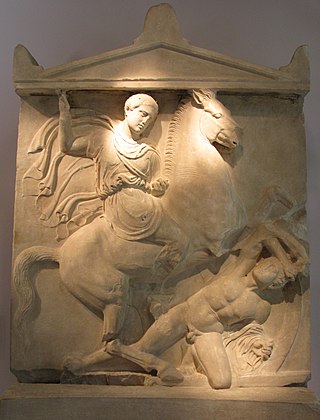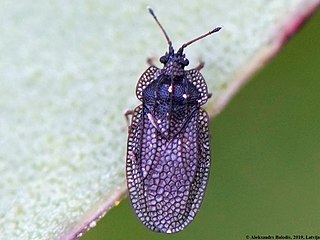
Theramenes was an Athenian military leader and statesman, prominent in the final decade of the Peloponnesian War. He was active during the two periods of oligarchic government at Athens, the 400 and later the Thirty Tyrants, as well as in the trial of the generals who had commanded at Arginusae in 406 BC. A moderate oligarch, he often found himself caught between the democrats on the one hand and the extremist oligarchs on the other. Successful in replacing a narrow oligarchy with a broader one in 411 BC, he failed to achieve the same end in 404 BC, and was executed by the extremists whose policies he had opposed.
The Battle of Aegospotami was a naval confrontation that took place in 405 BC and was the last major battle of the Peloponnesian War. In the battle, a Spartan fleet under Lysander destroyed the Athenian navy. This effectively ended the war, since Athens could not import grain or communicate with its empire without control of the sea.
The Thirty Tyrants were an oligarchy that briefly ruled Athens from 405 BC to 404 BC. Installed into power by the Spartans after the Athenian surrender in the Peloponnesian War, the Thirty became known for their tyrannical rule, first being called "The Thirty Tyrants" by Polycrates. Although they maintained power for only eight months, their reign resulted in the killing of 5% of the Athenian population, the confiscation of citizens' property, and the exile of other democratic supporters.
The Battle of Cyzicus took place in May or June 410 BC during the Peloponnesian War. During the battle, an Athenian fleet commanded by Alcibiades, Thrasybulus, and Theramenes routed and destroyed a Spartan fleet commanded by Mindarus. The victory allowed Athens to recover control over a number of cities in the Hellespont over the next year. In the wake of their defeat, the Spartans made a peace offer, which the Athenians rejected.

The Corinthian War was a conflict in ancient Greece which pitted Sparta against a coalition of city-states comprising Thebes, Athens, Corinth and Argos, backed by the Achaemenid Empire. The war was caused by dissatisfaction with Spartan imperialism in the aftermath of the Peloponnesian War, both from Athens, the defeated side in that conflict, and from Sparta's former allies, Corinth and Thebes, who had not been properly rewarded. Taking advantage of the fact that the Spartan king Agesilaus II was away campaigning in Asia against the Achaemenid Empire, Thebes, Athens, Corinth and Argos forged an alliance in 395 BC with the goal of ending Spartan hegemony over Greece; the allies' war council was located in Corinth, which gave its name to the war. By the end of the conflict, the allies had failed to end Spartan hegemony over Greece, although Sparta was durably weakened by the war.
Agesipolis I was the twenty-first of the kings of the Agiad dynasty in ancient Sparta.

Hellenica simply means writings on Greek (Hellenic) subjects. Several histories of 4th-century Greece, written in the mould of Thucydides or straying from it, have borne the conventional Latin title Hellenica. The surviving Hellenica is an important work of the Ancient Greek writer Xenophon and one of the principal sources for the last seven years of the Peloponnesian War not covered by Thucydides, as well as the war's aftermath.

The Battle of Lechaeum was fought between the Athenians and the Spartans during the Corinthian War; it ended in an Athenian victory. During the battle, the Athenian general Iphicrates took advantage of the situation when a Spartan hoplite regiment operating near Corinth was marching through open terrain without the protection of any missile throwing troops. He decided to ambush it with his force of javelin throwers, or peltasts. By launching repeated hit-and-run attacks against the Spartan formation, Iphicrates and his men were able to wear the Spartans down, eventually routing them and killing just under half. This marked one of the first occasions in Greek military history on which a force of peltasts had defeated a force of hoplite heavy infantry.

Pine honey is a type of honeydew honey. It is a sweet and spicy honey, with some woody notes, a resinous fragrance and dark amber color. It is a common breakfast dish in Turkey and Greece, where it is drizzled over yoghurt and eaten with bread.

The Second Athenian League was a maritime confederation of Greek city-states that existed from 378 to 355 BC under the leadership (hegemony) of Athens. The alliance represented a partial revival of the Delian League, which had been disbanded in 404 BC following the defeat of Athens in the Peloponnesian War. The new League was centered in the Aegean and included over 60 states, among which were Kos, Mytilene, Rhodes, and Byzantium. It was primarily formed as a defensive alliance against Sparta and secondly the Persian Empire. The new League's main objective was to preserve peace in Greece and counterbalance Sparta's growing hegemony and aggression. The League largely revived Athenian influence in the Greek world, reestablishing it as the strongest naval power in the eastern Mediterranean. This time, Athens made conscious efforts to avoid the strict terms that had eventually rendered the previous Delian League unpopular. The alliance lasted until 355 BC, when most of the allied cities became independent following the Social War that broke out in 357 BC.
Gambrium or Gambrion, also Gambreium or Gambreion (Γάμβρειον), was a town of ancient Aeolis and of Mysia, quite close to Pergamum. Its location is near Kınık and Bergama in İzmir province, in the Aegean Region of Turkey.
Thibron was a Spartan general. He was sent out as harmost in 400 BC, with an army of about 5,000 men, composed of 1,000 Neodamodes and 4,000 other Peleponesians, to aid the Ionians against Tissaphernes, who wished to bring them into subjection. In addition to this force, Thibron recruited 2,000 local troops upon his arrival, but was initially unable to face the Persian army in the field. However, after he was joined by elements of the Ten Thousand, he was able to seize several cities. He then, according to Xenophon, settled in to besiege Larissa, but this proved fruitless, and Thibron was ordered to abandon it. Diodorus suggests that at some point, after taking Magnesia, Thibron attempted to conquer Tralles in Ionia, but was unsuccessful and returned to Magnesia. He is then said to have withdrawn to Ephesus after Tissaphernes arrived with a large force of cavalry. In any case, Thibron was recalled to Sparta and replaced by another general, Dercylidas, before he could launch his next campaign. Upon his return to Sparta Thibron was tried and exiled for allowing his troops to plunder Sparta's allies in the region.
Leucophrys or Leukophrys was a town of the ancient Ionia, and earlier of Caria in the plain of the Maeander river. It was on the borders of a lake, whose water was hot and in constant commotion. The town possessed a very revered sanctuary of Artemis; hence surnamed Artemis Leucophryene or Leucophryne. The poet Nicander spoke of Leucophrys as a place distinguished for its fine roses. Xenophon records that, in 398 BCE, Leucophrys was the site to which the Greek troops, under the command of the Spartan Dercylidas withdrew after the meeting between them and the troops of Achaemenid Empire led by the satraps Tissaphernes and Pharnabazus II. The next day in the place they had agreed to, they negotiated peace. The Persians would allow the Greek cities to be autonomous and the Greek army and the Laconian harmosts would return across the Aegean Sea.
Iris hellenica is a plant species in the genus Iris and the subgenus Iris. It is a rhizomatous perennial, from Saitas Mountain, in the Peloponnese Region of Greece. It has grey-green, sickle-shaped leaves, a tall slender stem, 2–3 white, lavender-blue, lilac or purple flowers and orange/purple beards. It was thought once to be a hybrid species of Iris germanica which also grows in the same area, before being separated into 2 species. It has only recently been published and is rarely cultivated as an ornamental plant in temperate regions.

Acalypta parvula is a species of lace bug in the family Tingidae. It is found in Africa, Europe and Northern Asia, and North America.

Acalypta is a genus of lace bugs in the family Tingidae. This genus is closely related to Dictyonota, Kalama and Derephysia: in the tribe Tingini.
Acalypta cooleyi, or Cooley's tingid, is a species of lace bug in the family Tingidae. It is found in Europe and Northern Asia, North America, and Southern Asia.
Acalypta nyctalis is a species of lace bug in the family Tingidae. It is found in North America.
Halisarna was a town of ancient Mysia on the north bank of the river Caïcus. The nearby towns of Halisarna, Pergamum, and Teuthrania had been given by the Persian king Darius I to the Spartan king Demaratus about the year 486 BCE for his help in the expedition against Greece. Demaratus's descendants continued to rule these cities at the beginning of the 4th century BCE. During the withdrawal of Pergamum from The March of the Ten Thousand, it was attacked by, among others, troops from Halisarna and Teuthrania under command of Procles, son of Demaratus. In the Hellenica, Xenophon relates that Halisarna, together with Pergamum, Teuthrania, Gambrium, Palaegambrium, Myrina and Gryneium were delivered by their rulers to the army that, under the command of the Spartan Thimbron, around the year 399 BCE, had come to the area to try to liberate the Greek colonies from the Persian domain.
Abarnis, also known as Abarnias, Abarnos (Ἄβαρνος), and Aparnis was a coastal town in ancient Mysia, on a promontory of the same name. Xenophon speaks of the place as where Conon, during his engagements with Lysander, stole the sails of the Spartan fleet, reorganized his fleet and fled to refuge with Evagoras I, while dispatching the Paralus to Athens to bring news from the battles.







